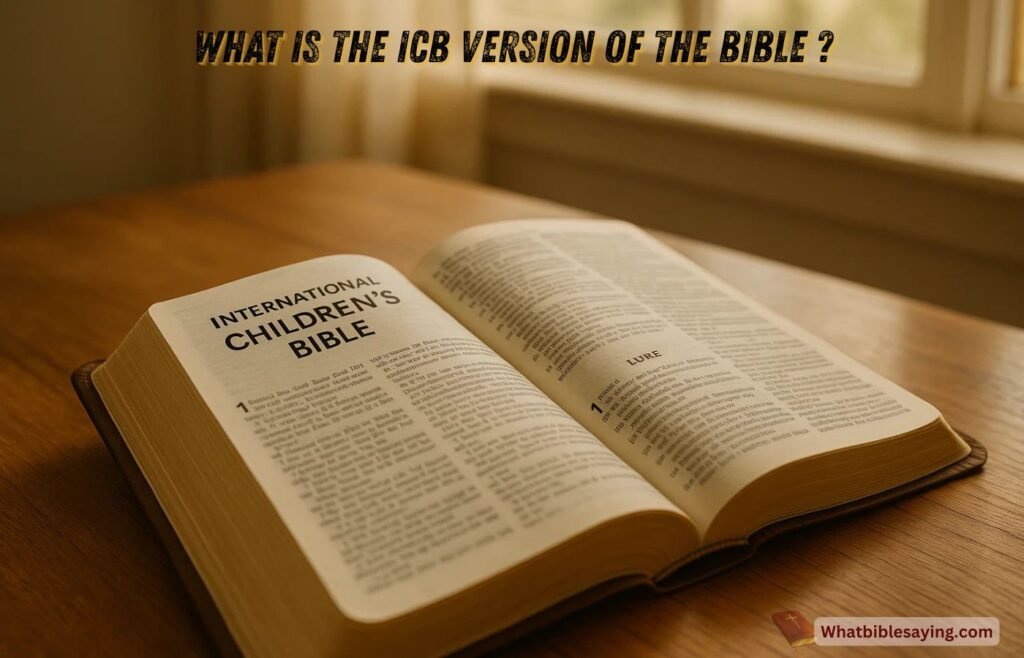 When you walk into a bookstore or search online for a Bible, the choices can feel overwhelming. King James Version, NIV, ESV, NLT, and then there’s the ICB, the International Children’s Bible. You may have asked yourself, “What is the ICB version of the Bible? Is it trustworthy? Who is it for?”
When you walk into a bookstore or search online for a Bible, the choices can feel overwhelming. King James Version, NIV, ESV, NLT, and then there’s the ICB, the International Children’s Bible. You may have asked yourself, “What is the ICB version of the Bible? Is it trustworthy? Who is it for?”
I’d like to take you by the hand, as a pastor and fellow traveler in the faith, and help you understand this translation in a way that makes sense for you, your family, and especially your children.
Understanding the ICB Bible Version
The International Children’s Bible (ICB) is a full translation of the Bible created specifically with children in mind. Unlike paraphrases or simplified story Bibles, the ICB is a complete Bible, translated directly from the original Hebrew and Greek texts.
It was first published in the 1980s by Thomas Nelson Publishers. The goal was simple but profound: make the Word of God accessible to children who read at a third-grade level. That means sentences are shorter, words are simpler, and theological terms are explained in plain English.
Where most translations might use words like sanctification, justification, propitiation, or transgression, the ICB replaces them with language children can understand. For example:
Instead of sanctification, it might say to be made holy.
Instead of transgression, it might simply say sin.
This does not mean the translators watered down the message. Instead, they carefully chose words that kept the meaning true while making the text readable for a younger audience.
Is ICB a Good Bible Translation?
This is one of the most common questions I hear from parents and Sunday school teachers: “Is the ICB a good Bible translation?”
The answer depends on what you’re looking for. Let’s explore its strengths and limits.
Strengths of the ICB
Clarity for children and new readers.
The ICB is written at a third-grade reading level, making it one of the easiest full Bibles to read.Faithful translation.
It’s not just a paraphrase, it was translated directly from the original Hebrew and Greek manuscripts. That gives it credibility as a true translation.Perfect for devotionals and family use.
Parents can read it aloud to children, and kids can begin to read it for themselves. It removes the intimidation factor.Helps new believers.
Even for adults who are new to faith or struggle with English as a second language, the ICB provides a wonderful introduction to Scripture.
Limitations of the ICB
Not designed for deep study.
Because it simplifies words, the ICB is not ideal for in-depth theological study. Adults may miss the richness of certain biblical terms.Some verses are phrased differently.
If you’re used to the KJV or NIV, you’ll notice differences. These are not errors but simplifications.Aimed at younger readers.
Mature believers may find it too simple for long-term daily reading.
So, is it a “good” translation? Yes, for its intended purpose. It shines as a teaching and devotional tool, especially for children, families, and beginners.
What Is the Difference Between ICB and Other Bibles?
Let’s compare the ICB with some of the most common versions you may know:
| Feature | ICB | KJV | NIV | ESV | NLT |
|---|---|---|---|---|---|
| Reading Level | 3rd grade | 12th grade | 7th–8th grade | 10th grade | 6th grade |
| Style | Simple, clear | Formal, old English | Balanced | Formal, word-for-word | Easy-to-read |
| Purpose | Kids, beginners | Tradition, poetic | Accessible, accurate | Study, precision | Devotional, clarity |
From this, you can see the ICB stands apart. It fills a gap by giving children their very own translation rather than expecting them to read adult versions.
Why Is Matthew 17:21 Missing from the ICB Bible?
If you flip through certain translations like the KJV, you’ll find Matthew 17:21:
“However, this kind does not go out except by prayer and fasting.” (NKJV)
But when you look at the ICB, or even modern versions like the NIV and ESV, you may not see this verse. Instead, you might find a footnote explaining it.
Why is it missing?
The answer lies in ancient manuscripts. When scholars compared the oldest and most reliable Greek texts of Matthew, they found that verse 21 wasn’t included in many of them. It seems that some later copies added it, possibly by borrowing from Mark 9:29, which says something very similar.
So, modern translations like the ICB chose to follow the most reliable manuscripts, leaving Matthew 17:21 out of the main text but often noting it in the footnotes.
This doesn’t mean the Bible was changed. It means translators were careful to stick with the best historical evidence we have. And the truth of prayer and fasting remains in other verses.
What Bible Is Closest to the Real Bible?
This question comes up often: “Which translation is the closest to the original Bible?”
The truth is, no English translation can be 100% identical to the Hebrew and Greek texts. Each translation makes choices, whether to prioritize word-for-word accuracy (like the ESV) or thought-for-thought clarity (like the NLT).
But for children and beginners, “closest to the real Bible” means a translation that faithfully carries God’s message without confusing them. In that sense, the ICB is one of the closest for young readers, not because it’s the most scholarly, but because it communicates God’s truth in a way they can truly understand.
If you’re asking as an adult seeking study depth, translations like the ESV, NASB, or NKJV are highly respected for being close to the original wording.
But if you’re a parent asking, “What Bible will help my child actually read and love Scripture?” the ICB is one of the closest to the heart of God’s Word.
Why the ICB Matters Today
We live in a time when children face endless distractions, TV shows, video games, social media, and constant noise. Getting kids to sit and read anything, let alone the Bible, feels like a miracle.
The ICB helps bridge that gap. It removes unnecessary barriers so kids can encounter God’s Word personally. I’ve seen children in my church beam with joy as they read their first Bible story on their own. Their eyes light up because they can finally understand.
That matters.
Because when God’s Word gets into the heart of a child, it can take root for life. Proverbs 22:6 reminds us:
“Train up a child in the way he should go, and when he is old he will not depart from it.”
The ICB is a tool to help us do just that.
Real-Life Stories of the ICB in Action
As a pastor, I’ve seen how the ICB changes lives. Let me share a few simple stories.
Emma, age 8. She struggled with reading and always felt left behind in Sunday school. When her teacher gave her an ICB, she could finally follow along. Her confidence grew, and she began volunteering to read aloud.
Marcus, a new believer. At 35, Marcus had never read the Bible. The KJV felt impossible for him. A friend gave him an ICB, and suddenly, Scripture became approachable. Within a year, he transitioned into the NIV and then the ESV, but the ICB was the doorway.
Family devotionals. One mother told me her family had tried reading the Bible together but the kids always lost interest. With the ICB, her children started asking questions and even reminded the family when it was time for devotions.
These aren’t just stories. They’re reminders that God’s Word is living and active, and when we present it in a way people can grasp, hearts are changed.
Criticisms of the ICB
Not everyone is a fan of simplified translations. Some critics argue that:
It removes important theological terms.
It may oversimplify deep truths.
It risks children not learning “church language.”
These are valid concerns. But I believe the benefits outweigh the drawbacks. Children can learn words like justification later. First, let’s help them fall in love with Jesus. Once that foundation is laid, the deeper vocabulary can come naturally.
How to Use the ICB in Daily Life
If you’re considering the ICB for yourself or your family, here are some practical ways to make the most of it:
Family devotion time. Read a passage together and let your child read aloud.
Bedtime routine. End the day with a short story from the ICB.
Church groups. Use it in Sunday school to make lessons clearer.
Personal growth. If you’re a new believer, don’t be ashamed to start here.
Gift idea. Give it to children at baptisms, confirmations, or birthdays.
Comparing ICB to Other Children’s Bibles
You might wonder how the ICB compares to popular children’s story Bibles. Here’s the difference:
Story Bibles (like The Beginner’s Bible) summarize stories and leave out large sections of Scripture. They’re great for toddlers.
ICB Bible is a full translation. Every book, every chapter, simplified but intact.
That makes the ICB unique, it’s the first Bible children can truly call their own.
Should Adults Read the ICB?
Absolutely. While it was designed for kids, adults can benefit too.
ESL learners find it easier than higher-level English Bibles.
New believers often start here before moving to other versions.
Even mature believers sometimes use it for devotional reading because of its refreshing simplicity.
It reminds us that God’s Word is not meant to be complicated.
Final Reflections: The Heart Behind the ICB
When we ask, “What is the ICB version of the Bible?” we’re really asking, “Does God’s Word speak to children too?”
The answer is yes. The ICB exists because God’s love is not just for scholars, pastors, or adults. It is for children. Jesus Himself said:
“Let the little children come to me, and do not hinder them, for the kingdom of heaven belongs to such as these.” (Matthew 19:14, NIV)
The ICB helps fulfill that invitation. It clears away the confusion and lets children hear the voice of Jesus clearly.
As a pastor, I recommend the ICB to families, new believers, and anyone who feels overwhelmed by traditional translations. It may not be the best Bible for lifelong study, but it’s one of the best for opening hearts.
And that’s what matters most.












